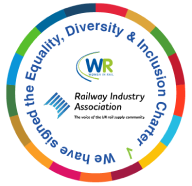The Government’s consultation document A railway fit for Britain’s future[1], sets out a backbone for what will become the new Railways Bill. While the consultation doesn’t seek to address the structure and arrangements needed, the debate is certainly live within our industry, around simplified solutions developed out of the learning from past structures and configurations for the sector in Great Britain. Consistently, though, the debate centres on how, rather than, whether, the worlds of track and train should be unified and aligned, systemically as well as commercially.
Figure 1. One of the iconic High-Speed Trains, created in the late 1970s just prior to sectorisation, pauses at York on 20th December 2019 during the Let’s Go Round Again railtour operated by the current LNER © Chris Hoskin

In early 2020, following the launch of the Williams Rail Review process, I was exploring this question of structure and drafted an internal analysis of options for how the railways could potentially be reformed, while noting that the current 20 franchises were already rationalised from the original 27 and rail-on-rail competition at major termini had fallen away as a central objective. Among different approaches, the analysis considered, as options, a recreation of the Big Four railway companies[2] or the five eventual British Rail Regions[3]. A further potential approach considered was a re-creation of the business units formed under sectorisation[4]. The Big Four, as an option I felt, would most likely be subdivided further, with devolved administrations in Scotland and Wales retaining their respective networks and powers. A benefit of this form of organisation would be that the new Regions would almost align with the Network Rail regions and would enable knowledge to be retained geographically where it was needed. I also felt that the mayoral regions would most likely make a compelling case for retaining or gaining local transport powers.
Figure 2. A comparison of the British Rail Regions (NE and E Regions were combined in 1967), and the Network Rail Routes and Regions

I revisited the structural question again in August 2024, with an Industry Insight Is sectorisation the answer?, examining the particular merits of a recreation of the business sectors established in the 1980s. This analysis contemplated the devolved and mayoral regions retaining and gaining their own networks and powers, and a further alignment of traffic and business types through some specific traffic transfers. These included the West Midlands Railway (WMR) element of the WMR/LNWR (London Northwestern Railway) franchise traffic network transferring to the West Midlands Combined Authority (WMCA), and TransPennine transferring to the InterCity sector rather than the Regional Railways sector, to facilitate peer focus and support.
Now I put all this aside. I put it on the shelf, from which the historians, when they have time, will select their documents to tell their stories. We have to think of the future and not of the past – Winston Churchill.
Having performed these analyses, it is not easy to see how an objective for GBR to “unite track and train at route level”[5] can be achieved without invoking some degree of sectorisation. However, from the great Winston’s quote, I take that it is pointless arguing about which were the good old days because they are now gone, and the environment in which they existed has also gone, so, even if we were able to, recreating something that worked in the past might not help now.
The focus on the structure is crucial to the pursuit of the “6 clear objectives”[6], potentially more so than a focus on ownership of the railways. Arguably, it is not the ownership that makes the structure work well (or not), it is the structure itself, along with the incentives and mechanisms in place to enable good working relationships and service delivery.
Figure 3. A product of Government intervention over the current private franchise operation; Prototype Azuma 800101 in its short-lived Virgin livery on test at York © Chris Hoskin

In his Modern Railways piece Railtalk: No place to hide for poor performance, Andy Roden captures the need to combine the outgoing knowledge of what has been made to work previously with the incoming stakeholders that will make the new world happen:
“In many ways GBR must relearn the art of operating a largely integrated railway, cross-pollinating expertise across infrastructure management, operations and maintenance. We are lucky in that we still, just, have experienced hands trained by BR in those areas. They are going to play a critical role in ensuring younger colleagues who have joined since privatisation get up to speed as quickly as possible. BR’s transformation in the 1980s was led by young managers. Chris Green was just 45 when he was appointed Director for what was called the London & The South East Sector and created Network South East. This time around, creation of GBR will be in the hands of the ‘Gen-Xers’ born between the mid-1960s and late-1970s.”[7]
As we contemplate another restructuring, I would tend to argue that the success will depend upon our harnessing the passion and wisdom of people that love our railway industry and all that it stands for, and can embrace cross-discipline collaboration without being constrained by historical contractual and legislative boundaries.
Our incredible railway industry is full of skilled and enthusiastic railway professionals, so skilled and enthusiastic that they take pleasure in investing their free time in non-commercial and heritage railways throughout the UK and internationally. In doing so, they amass an extraordinary breadth of knowledge and experience relating to different railway regimes, as well as knowledge and experience in aspects of railway operation that would otherwise be outside their own particular discipline. In these railway organisations, we see integrated systems, albeit often on a smaller scale, and the younger, post-privatisation, generations are at least as interested and involved as their seniors are, in utilising the opportunities enabled by these railways to deploy and hone their integrated railway expertise and wisdom.
With a suitable structure in place that enables us to get on with what we do best, I would suggest that it is our love of railways and what we can achieve together, that will drive our success.
Figure 4. Integrated railway: Train operations and infrastructure, multi-generational rail experts and enthusiasts, all participating within a combined system and with a common goal © Ffestiniog & Welsh Highland Railways

 | Chris Hoskin is a Director and Head of Technical at IPEX Consulting. He joined the industry as an undergraduate in 1998 at the Railway Technical Centre in Derby. He has worked predominantly in the UK and Australasia, with other projects covering South East Asia, the Middle East, and North and South America. Concentrating most of his time on rolling stock procurement and strategy, he is also a volunteer on the Ffestiniog Railway. One-time part of locomotive overhaul teams, Fireman, Signalman, and occasional P-Way volunteer, he now is part of the team that restores the slate waggons and operates the gravity trains. |
[1] A railway fit for Britain’s future, HM Government, February 2025, https://assets.publishing.service.gov.uk/media/67b30eb94a80c6718b55bdf6/a-railway-fit-for-britains-future-print.pdf.
[2] Between 1923 and 1947, Great Western Railway (GWR), London, Midland and Scottish Railway (LMS), London and North Eastern Railway (LNER), and Southern Railway (SR) together comprised the railways in Great Britain.
[3] At Nationalisation in 1948, the original Big Four railway companies became regions, but with Scotland having its own region consisting of elements of the LMS and LNER. LNER was further divided into Eastern Region and North Eastern Region. In 1967 boundary changes resulted in the five Regions of Eastern, London Midland, Scottish, Southern, and Western. These, again with some modifications, remain today in Network Rail Regions.
[4] Under Sectorisation in 1982, railway traffic was divided between InterCity, London & South East (renamed Network SouthEast in 1986), Provincial (renamed Regional Railways in 1989), Freight (further sub-divided into distinct traffic types) and Parcels, though the railway infrastructure retained the regional structure.
[5] A railway fit for Britain’s future, 1.7 p17
[6] A railway fit for Britain’s future, p7
[7] Andy Roden, Railtalk: No place to hide for poor performance, Modern Railways, 24 March 2025, https://www.modernrailwaysinsight.com/view_article.asp?ID=9085




